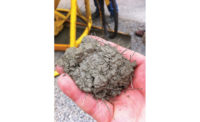Graphics processing units are playing a key role in attacking some of society's toughest problems, such as diagnosing and treating diseases and powering simulations for breakthroughs in scientific discoveries. Sophisticated GPUs deliver the horsepower behind deep learning, a system for artificial intelligence programming modeled after the human brain.
With deep learning, computers learn from experience—the same way people do. In the past two years, deep learning has contributed to more progress in health care, agriculture, automobiles and cybersecurity than earlier technologies had in the previous decade.
As deep-learning solutions have become a reality, the number of problems we can imagine solving with the use of artificial intelligence has exploded. The AI revolution is here, and even experts don't know what that means beyond this: Almost all industries, including construction, will be affected. But how?
This past May, my company—NVIDIA, which makes GPUs that are used in millions of computing devices, workstations and data centers, serving all kinds of industries—presented our first-ever NVIDIA Inception Awards, which are aimed at finding and rewarding start-ups that are making a difference using AI. Out of 600 companies, 14 finalists were chosen to pitch to a panel of judges that included our CEO, Jensen Huang, and leaders from Goldman Sachs, Fidelity Investments, Softbank Group Corp. and Microsoft. Winners and runners-up were chosen in three categories: Hottest Emerging, Most Disruptive, and Best Social Innovation. The runner-up for Most Disruptive went to an AEC start-up called Smartvid.io, which has created a software to inspect project photos and videos from construction sites to detect safety risks automatically. Think of it as a jobsite inspector who never sleeps.
Construction is the second-largest industry in the world and, unfortunately, one of the least safe, currently causing 20% of U.S. worker deaths, according to the U.S. Dept. of Labor. Construction companies and insurers send trained safety experts to inspect jobsites every day, but they're expensive and there aren't enough to go around, making it impossible for every site to get the attention it needs.
But every week, millions of documentation pictures and videos are taken on projects worldwide. Smartvid.io has figured out how to mine that existing data, most of which sits idly in project management systems, to help solve the jobsite safety problem.
Smartvid.io takes advantage of one of the most successful applications of deep learning: computer vision, or technology that makes it possible for computers to "see" and recognize what's in a picture. It's both tireless and all-seeing, often surpassing human vision. Just as your phone can identify faces in a picture, computer-vision engines can be trained to spot things that are missing, from a worker not wearing a hardhat or safety vest to scaffolding or stairs that lack railings.
How does it do that? It's not with algorithms written by programmers. Instead, Smartvid.io showed its AI engines hundreds of thousands of photos of construction sites that human inspectors determined as either safe or dangerous. The system then figured out for itself what it should look for to determine what constitutes "dangerous." This is the magic: A deep-learning system can debug itself as it analyzes the data for the problem at hand.
Other AI-based areas that are developing quickly in the AEC space include deep-learning-enabled generative design software, as well as de-noising of photorealistic renderings for accelerated design visualization of building interiors and exteriors. Probably more directly related to the construction industry is the progress being made with autonomous construction vehicles and heavy equipment. Leading manufacturers have demonstrated prototypes of self-driving dump trucks and front loaders. In the not-too-distant future, autonomous construction equipment, including bulldozers, graders and excavators, will be a common sight on jobsites around the world. AI is expected to continue making important contributions to safer construction environments.
Generally, there are two kinds of AI solutions: fully autonomous tools, such as self-driving vehicles or car-welding robots, and technology that complements human judgment, yielding insights we just don't have time to find on our own. Our judges recognized Smartvid.io as a perfect example of the latter. Right up the alley of deep-learning technology, it could greatly improve not only safety but also productivity and quality in construction worldwide. And while every industry has a stake in this unknown future, few industries are more important or have more potential to capitalize on deep learning than AEC.
Construction is a worldwide, multitrillion-dollar industry that is projected to reach $10 trillion by 2020, according to market reports based on data released by the Construction Intelligence Center. As such, it's a cornerstone that serves every other sector and has a major influence on the economy, the environment and our quality of life. Its scale makes its decisions unusually powerful: Even a tiny change can have a big impact on society, for better or worse. It is also an industry that stands to benefit in a big way from technology driven by deep learning. Deep learning undoubtedly can improve many areas of construction, but construction managers will need to educate themselves about the ability of technology to fix deficiencies that have come to be accepted as a given—the notion that construction is inherently unsafe, for example.
The tech world is looking to construction professionals—architects, engineers, contractors and the readers of ENR—not only to keep informed about new technology but also to use leading-edge solutions to tackle intractable problems.
The arrival of deep learning has made many technologist dreams come true. The Inception Awards saw those visions come to practical life. As our CEO told the contestants at the closing event, "We are genuinely touched by the work you do." And we can't wait to see what AEC does next. After all, we all live in a world that architects, engineers and contractors create.
—Andrew Rink leads AEC industry marketing strategy at NVIDIA, whose products power everything from workstations for designing buildings to self-driving cars and cutting-edge health-care research.





Post a comment to this article
Report Abusive Comment